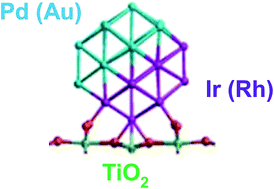当前位置:
X-MOL 学术
›
Faraday Discuss.
›
论文详情
Our official English website, www.x-mol.net, welcomes your feedback! (Note: you will need to create a separate account there.)
Modelling free and oxide-supported nanoalloy catalysts: comparison of bulk-immiscible Pd–Ir and Au–Rh systems and influence of a TiO2 support
Faraday Discussions ( IF 3.4 ) Pub Date : 2018-01-19 , DOI: 10.1039/c7fd00213k Ilker Demiroglu 1, 2, 3, 4, 5 , Tian-E. Fan 1, 2, 3, 4, 6 , Z. Y. Li 2, 3, 4, 7, 8 , Jun Yuan 4, 9, 10, 11 , Tun-Dong Liu 6, 12, 13, 14 , Laurent Piccolo 15, 16, 17, 18, 19 , Roy L. Johnston 1, 2, 3, 4
Faraday Discussions ( IF 3.4 ) Pub Date : 2018-01-19 , DOI: 10.1039/c7fd00213k Ilker Demiroglu 1, 2, 3, 4, 5 , Tian-E. Fan 1, 2, 3, 4, 6 , Z. Y. Li 2, 3, 4, 7, 8 , Jun Yuan 4, 9, 10, 11 , Tun-Dong Liu 6, 12, 13, 14 , Laurent Piccolo 15, 16, 17, 18, 19 , Roy L. Johnston 1, 2, 3, 4
Affiliation

|
The relative stabilities of different chemical arrangements of Pd–Ir and Au–Rh nanoalloys (and their pure metal equivalents) are studied, for a range of compositions, for fcc truncated octahedral 38- and 79-atom nanoparticles (NPs). For the 38-atom NPs, comparisons are made of pure and alloy NPs supported on a TiO2(110) slab. The relative energies of different chemical arrangements are found to be similar for Pd–Ir and Au–Rh nanoalloys, and depend on the cohesive and surface energies of the component metals. For supported nanoalloys on TiO2, the interaction with the surface is greater for Ir (Rh) than Pd (Au): most of the pure NPs and nanoalloys preferentially bind to the TiO2 surface in an edge-on configuration. When Au–Rh nanoalloys are bound to the surface through Au, the surface binding strength is lower than for the pure Au NP, while the Pd-surface interaction is found to be greater for Pd–Ir nanoalloys than for the pure Pd NP. However, alloying leads to very little difference in Ir-surface and Rh-surface binding strength. Comparing the relative stabilities of the TiO2-supported NPs, the results for Pd–Ir and Au–Rh nanoalloys are the same: supported Janus NPs, whose Ir (Rh) atoms bind to the TiO2 surface, bind most strongly to the surface, becoming closer in energy to the core–shell configurations (Ir@Pd and Rh@Au) which are favoured for the free particles.
中文翻译:

模拟游离态和氧化物负载型纳米合金催化剂:本体不混溶的Pd-Ir和Au-Rh体系的比较以及TiO 2载体的影响
对于fcc截短的八面体38和79原子纳米颗粒(NP),研究了Pd-Ir和Au-Rh纳米合金(及其纯金属等价物)不同化学排列的相对稳定性。对于38个原子的NP,比较了负载在TiO 2(110)平板上的纯NP和合金NP 。对于Pd-Ir和Au-Rh纳米合金,发现不同化学排列的相对能量相似,并且取决于组分金属的内聚能和表面能。对于TiO 2上负载的纳米合金,Ir(Rh)的表面相互作用大于Pd(Au):大多数纯NP和纳米合金优先结合TiO 2表面呈边缘配置。当Au–Rh纳米合金通过Au与表面结合时,其表面结合强度低于纯Au NP,而Pd–Ir纳米合金的Pd-表面相互作用要大于纯Pd NP。但是,合金化导致Ir表面和Rh表面结合强度的差异很小。比较TiO 2负载的NPs的相对稳定性,Pd–Ir和Au–Rh纳米合金的结果相同:负载的Janus NP,其Ir(Rh)原子与TiO 2表面结合,与表面的结合最牢固,使能量变得更接近于核-壳结构(Ir @ Pd和Rh @ Au),这是自由粒子的首选。
更新日期:2018-09-03
中文翻译:

模拟游离态和氧化物负载型纳米合金催化剂:本体不混溶的Pd-Ir和Au-Rh体系的比较以及TiO 2载体的影响
对于fcc截短的八面体38和79原子纳米颗粒(NP),研究了Pd-Ir和Au-Rh纳米合金(及其纯金属等价物)不同化学排列的相对稳定性。对于38个原子的NP,比较了负载在TiO 2(110)平板上的纯NP和合金NP 。对于Pd-Ir和Au-Rh纳米合金,发现不同化学排列的相对能量相似,并且取决于组分金属的内聚能和表面能。对于TiO 2上负载的纳米合金,Ir(Rh)的表面相互作用大于Pd(Au):大多数纯NP和纳米合金优先结合TiO 2表面呈边缘配置。当Au–Rh纳米合金通过Au与表面结合时,其表面结合强度低于纯Au NP,而Pd–Ir纳米合金的Pd-表面相互作用要大于纯Pd NP。但是,合金化导致Ir表面和Rh表面结合强度的差异很小。比较TiO 2负载的NPs的相对稳定性,Pd–Ir和Au–Rh纳米合金的结果相同:负载的Janus NP,其Ir(Rh)原子与TiO 2表面结合,与表面的结合最牢固,使能量变得更接近于核-壳结构(Ir @ Pd和Rh @ Au),这是自由粒子的首选。


























 京公网安备 11010802027423号
京公网安备 11010802027423号